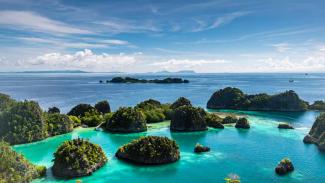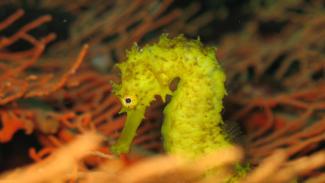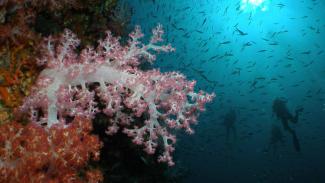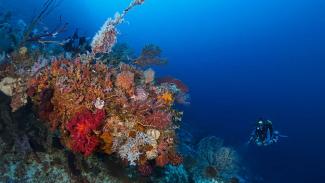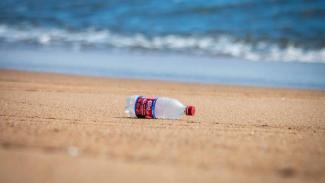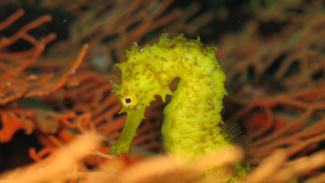
With almost 100,000 sq km of coral reefs, 51 different species of mangrove and 23 species of sea-grass, South-east Asia supports the most diverse collection of life on earth.
Unfortunately, this kaleidoscope of life may be on the brink of collapse. The consequences of human activity are putting pressure on this environment & its inhabitants every day, with south-east Asia's reef considered to be the most threatened on earth.
Here, we outline some of the key threats to south-east Asia's marine eco-systems.
Tipping the Scales
In addition to a wealth of marine life, south-east Asia is also home to over half a billion people. Around 350 million people live on or near the coast and the vast majority of this ever growing population survive from the sea or benefit from the seas depleted riches. Asians have been living in harmony with the sea for centuries, but as with many regions, the dramatic rise in the population in recent years has tipped the scales.
The UN's Reefs at Risk study concludes human activities are now thought to threaten 88% of South-east Asia's coral reefs, 50% of the region's reefs are considered to be at 'high' or 'very high' and only 12% are considered to be at low risk of collapse. Add in the effects of climate change & you have a potentially devastating collection of threats.
Over-fishing
One of the most direct consequences of this situation is over-fishing. Current fishing quotas are simply not sustainable and the situation is exacerbated by huge amounts of illegal fishing every day. Improvements in technology, greed and poor management have resulted in fish stocks being devastated in recent years, with 90% of the world's larger fish already fished out. At present, stocks of Tuna are on the brink of collapse from rampant over-fishing.
Destructive Practices
Allied to over-fishing, the techniques used to catch fish is also creating a huge problem. Some fisherman employ a wide-range of destructive techniques in order to catch as many fish as possible in as little time as possible. Some of the techniques currently used are:
- Blast-fishing - in which dynamite is used to blast open a portion of coral reef, killing everything within range.
- Cyanide-fishing - where sodium cyanide is used to stun fish, making them easy to catch, but not killing them. This technique is used both for the aquarium trade and to provide live fish for restaurants, primarily in China, Hong Kong & Singapore. It is estimated that, for every live fish caught using cyanide, 1 square metre of reef is destroyed. Each year, 20,000 tonnes of live fish are consumed in Hong Kong alone (source: WWF).
- Longline fishing - a commercial fishing technique whereby long fishing lines with hundreds, or even thousands of baited hooks are trailed behind a boat. These hooks not only catch their intended prey very effectively, but also create a huge amount of by-catch - animals caught unintentionally on the hooks. This by-catch often includes many endangered creatures, including sharks, turtles and sea-birds.
- Ghost-fishing - not so much a technique as an act of carelessness. Every year, many kilometres of fishing nets are lost or abandoned. These nets continue to catch fish though, which are trapped in the nets until they die a slow and painful death.
Pollution
Pollution from the regions ever growing towns, cites, industries & agriculture which enters the seas either directly or as run-off is causing havoc with marine habitats.
Many pollutants upset the chemical balance of coastal seas, increasing levels of nitrogen which in turn promotes excessive algae growth, smothering reefs and eventually killing them off. Many bacteria also enter our seas with our sewage, resulting in a significant increase in coral diseases. Even sun-cream is though to be very damaging to coral reefs.
Construction activity, deforestation & the destruction of mangrove habitats is also resulting in a significant increase in sedimentation, which also smothers reefs and prevents the sunlight crucial for survival getting through.
The amount of rubbish, especially plastic that ends up in the ocean is also a major threat, with many creatures eating or become entangled in human waste. Turtles, Whales, Seals & Birds often mistake plastic bags for jellyfish, which blocks their digestive system, meaning they simply starve to death.
Careless Tourism
Tourists are not exempt from blame either. South-east Asia attracts millions of tourists each year, many of which come to enjoy the area's beaches and islands. The development of large, badly resorts in sensitive areas creates sewage and sediment in our seas.
Unfortunately people still damage coral reefs too by kicking, touching or walking over the coral, boats still sometimes drop anchor on reefs and boat traffic can inadvertently kill marine life.
Rays of Hope
All in all, we are in a pretty sorry state and have created a catalogue of problems. These problems are now coming into focus as we begin to appreciate just how much we rely on the oceans & the economic value they hold for us. This self-interest could be the saving grace for our oceans as governments, organisations & communities realise the benefits of healthy marine environments.
Coral Reefs alone are estimated to provide us with US$375 billion worth of benefits every year from a combination of food, tourism & coastal protection.
MPAs, or Marine Protected Areas are proving to be a very effective method of managing fish stocks. Under the system, no-take zones are created, in which no fishing of any kind is permitted. As marine life in this area thrives, surrounding areas which can be fished benefit from increased fish-stocks - creating a win-win situation for both marine life and fishing communities.
Marine environments, particularly coral reefs are of huge economic value as a tourist attraction as well, providing a motivation to care & nurture these environments.
Coral Reefs & Mangrove Forests also provide protection from storms and adverse weather conditions for communities. In areas where these have been destroyed or depleted, local people are now campaigning to rejuvenate the areas in order to protect their homes & livelihoods from the weather.
A recent study has concluded that the destruction of one kilometre of coral reef is likely to cost up to $1.2 million in lost benefits over the course of 25 years.
An appreciation of these benefits is beginning to gain ground, but much more work is needed to turn this situation around and tomorrow may well be too late. So if you care about the sea, now is the time to make your voice heard and help to save our special seas & oceans.
You might also enjoy...
The triangle of life
The underwater world of South-East Asia has long been famed for its wealth & diversity of marine life. But it is only relatively recently that scientists have begun to get a hold on just how diverse and special the area is.
Asia's endangered species
Tara North
Asia is home to some of the most diverse habitats in the world, both above and below the water, but it is estimated that more than one in three species are endangered... and the figure is rising alarmingly fast.
Underwater, a whole range of pressures are putting marine life under immense pressure. Intense population pressure is leading to over-fishing, pollution and the destruction of crucial habitats.
The seas of Asia
Asia is caught between two huge oceans, the Indian Ocean to the west and the Pacific to the east. In between is a complex geography of land & water that has given rise to some of the most fascinating & species rich seas on our planet.
Getting technical
Christian Gloor
Have you ever found yourself diving on a reef wall and wondering what lurks in the depths below? Or longed to spend more than a few fleeting moments exploring a mysterious & historic shipwreck?
Then maybe technical diving is the sport for you. Increasing numbers of divers, eager to explore beyond the bounds of recreational limits, are taking an interest in technical diving.
Fish identification
Christian Gloor
For many divers the thrill of spotting and identifying a new fish is one of the reasons they love to dive.
But identifying a new fish is never that easy, especially considering the sheer abundance of different species that make their home in Asia's incredible reefs.
So we've put together some tips to help you to improve your identification skills and get more out of your diving.
Get Involved
Brian Yurastis


